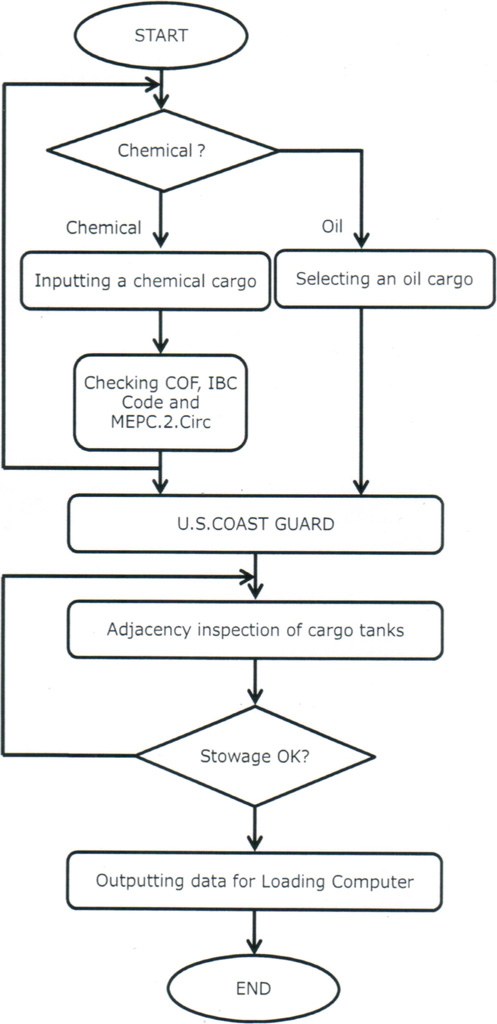Oil & Chemical Cargo Loading System "Chemical-Hi"
This program is used for safe voyage plans of vessels and loading various chemical cargoes.
To load the chemical cargoes safely, which are planned to be loaded, the program carries out adjacency inspection of chemical cargo to be loaded into each tank according to the rules of the class.
Also, my company is to revise the databases like COF, IBC Code and MPEC and provide users with them every year.
Systeml Contents
This program carries out adjacency inspections when chemical cargoes which are in IBC Code Ch.17/Ch.18 and MEPC. 2/Circ "Provisional Categorization of Liquid substance in Accordance with Marpol AnnexⅡ and The IBC Code." LIST 1 of IMO, also oil cargoes which are in MARPOL Annex I-Appendix 1, are loaded. This has a function to plan stowage comply with those rules.
- About chemical cargoes, whether they are in COF of a ship, when they are not in COF, whether they are in IBC Code Ch.17/Ch.18, and MEPC2/Circ LIST1, the program searches step by step.
Oil cargoes are selected from MARPOL Annex I-Appendix 1.
You can input a cargo which is not found in each list, however, its loading plan should be done on the ship’s own responsibility. - The program uses the U.S. Coast Guard Chart for adjacency inspections.
Adjacency inspections are not done about cargoes not found in IBC Code Ch.17/Ch.18, in MEPC.2/Circ LIST1 and in MARPOL Annex I-Appendix 1.
Adjacency inspections are not done generally about cargoes not found in the Alphabetical List of Cargoes of U.S. Coast Guard, or cargoes assigned Group 0. - It also carries out inspections about the adjacency with heated other cargoes and the adjacency with water.
- "Adjacency" in an adjacency inspection means "surface contact" about the adjacency with the cargoes reactive each other and with water. It means "point contact" about the adjacency with heated other cargoes.
- After a loading plan is completed, the program outputs CARGO LOADING PLAN to the Loading Computer.
Systeml Flow

Program Screen

| ① | Creating a new condition | ② | Calling up a saved condition | ③ | Calling up a Trial condition |
| ④ | Saving and deleting conditions | ⑤ | Inputting a substance name of a chemical cargo | ⑥ | Search oils |
| ⑦ | Search chemicals | ⑧ | Search results of chemical cargoes | ⑨ | Material No. |
| ⑩ | Substance name of the cargo | ⑪ | Total weight of each cargo | ⑫ | Check for heating |
| ⑬ | Check for avoiding overheating | ⑭ | Saving and calling up SDS | ⑮ | Deleting the registered cargo in history |
| ⑯ | Outputting to Loadstar | ⑰ | Printing | ⑱ | Deleting Cleaning Information (only a selected cell) |
| ⑲ | Deleting Cleaning Information (all cells) | ⑳ | Adjacency inspection | ㉑ | Showing tank plots |
| ㉒ | NG display of adjacency inspection | ㉓ | Tank No. & Tank Name | ㉔ | Density |
| ㉕ | Weight | ㉖ | Weight ⁄ ( MaxV*S.G. ) * 100 | ㉗ | This time: loaded cargo Material No. |
| ㉘ | This time: inputting about cleaning | ㉙ | Last time: loaded cargo Material No. | ㉚ | Last time: inputting about cleaning |
| ㉛ | Before the last time: loaded cargo Material No. | ㉜ | Before the last time: inputting about cleaning | ㉝ | Three times before: loaded cargo Material No. |
| ㉞ | Three times before: inputting about cleaning | ㉟ | Remark | ㊱ | Marpol Annex |
| ㊲ | IBC chapter or MEPC | ㊳ | Pollution Category | ㊴ | Hasards |
| ㊵ | Ship Type | ㊶ | Tank Type | ㊷ | CHRIS CODE |
| ㊸ | Slop Tank |
Output
Condition output

Freight type
